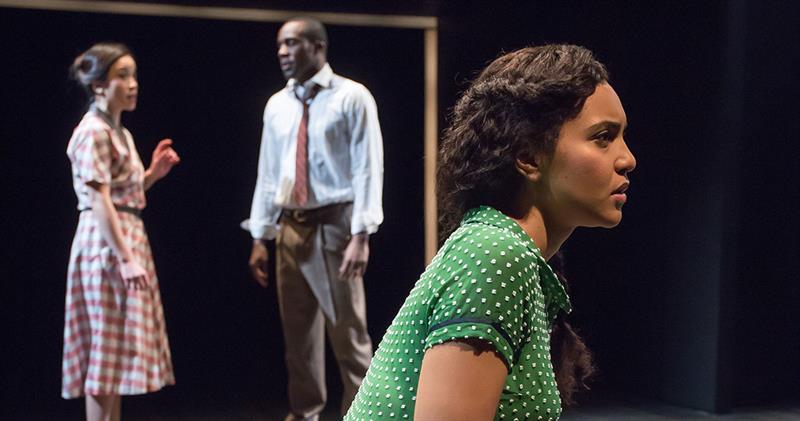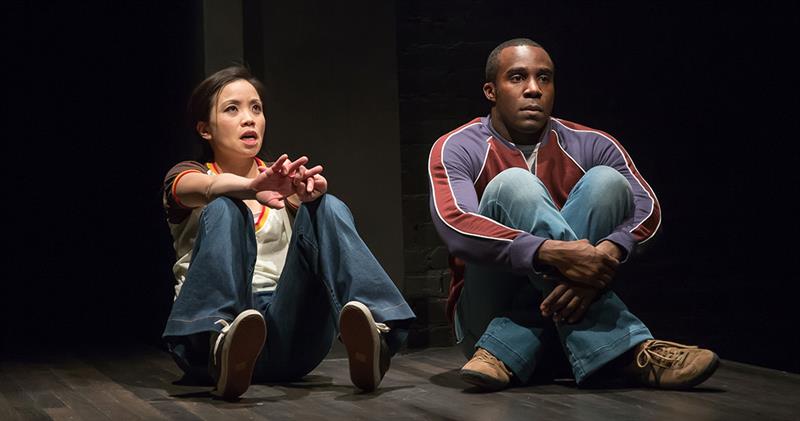American Culture from the Glamour of the 1950s to the Community of the 2000s
June 20, 2017

Jen Silverman’s world premiere play All the Roads Home follows three generations of women through their pursuit of dreams and the legacies they inherit. Through Madeleine, Max and Nix, Silverman takes the audience from the 1950s, 1970s and into today. Each of the characters offers a glimpse into how the culture of each time period led them to the life choices they made and, ultimately, their destinies.
In part one, Madeleine offers a wide-eyed perspective on the endless possibilities that New York City can offer her as a young dreamer. She wants to become a dancer, not unlike the countless others vying to be a part of the entertainment industry as actors, singers and models. Yet her dreams of being a dancer reveal a deeper desire to experience life with more excitement than her Massachusetts home town could give her.
The 1950s were a prosperous time for America. The country had just come out of World War II, victorious and more powerful than ever with a robust economy. Many couples rushed to the altar to settle into a more stable way of life. Male veterans went back into the workforce or went to college on the G.I. bill, and many women married and became housewives. The American dream of the nuclear family was becoming a quick reality.
Yet not all women had chosen to become wives and mothers. Like Madeleine, some pursued ambition in all kinds of professions and found themselves drawn to the cultural capital of the world: New York City. It was the birthplace of a new kind of American girl—the young single woman in the city—and she appeared to be radically different from her married female counterparts. She was independent, self-sustaining and determined to forge a life on her own.

The decade insisted on upholding traditional gender roles and single women in the city posed various “concerns.” Social pressures dictated that they shouldn’t live alone, that they should always fear strangers, or that their lack of a male partner should make married women suspicious and other men responsible for their well-being. The single woman internalized this kind of messaging in the face of her lifestyle, making it more challenging to fully realize her dreams. After all, she was a new figure on the cusp of a new time.
Part two stars Madeleine’s daughter Max—a strong-willed and angsty teenager whose true happiness exists far outside of her Massachusetts town. “Me, I’m living in a suburb,” she explains dramatically. “This isn’t America, this is hell.”
Max introduces the audience to country music legend Dolly Parton as her dream girl in more ways than one. Dolly has country-tough prowess and an individualistic perspective that’s rather enthralling to Max. She boasts about how the country lifestyle simply teaches folks whatever they need to know, since they don’t believe in “the tyranny of education.”

In the 1970s, America found itself in a malaise of exhaustion from the social upheaval of the 1960s. The Vietnam War, the battle for civil rights and liberation, and the overall disillusionment from so much violence at home and abroad had made Americans cynical. Young people rebelled in their own ways, swapping the radical political engagement of the 1960s for a more a relaxed, personal outlook on image, spirituality and sexual identity. The economic prosperity of the post-war boom had waned, and institutions of government and the public sphere were tarnished. The country pointed its interests towards the private sector, and specifically towards the South and Southwest. The “Sun Belt,” as it was called, had become a hub for enterprise, and the culture of these locales carried over into the mainstream.
Following suit, Max dreams of being a cowboy, using her own self-reliance as Dolly would in the country. She desires the masculinity and strength that it takes to be a part of the country lifestyle and longs to escape Massachusetts. An opportunity arises when she meets another teenager who dreams of going west where the culture embraced freedom and a lack of rigid structure. The west promised southern individualism coupled with a hippie counterculture, which existed now in communities and not within society at large. It gestured towards a new frontier that would, in due time, celebrate the individual’s right to self-expression, identity and dreaming.

Fast forward a couple of decades, and part three features Nix, the granddaughter of Madeleine and the daughter of Max in the second decade of the 2000s. She is a singer and guitar player who is already on the road, playing in bars and clubs. She has come of age under the culturally prescribed mindset that she is entitled to and encouraged to dream big.
In America today, the millennial has taken the ambitious pursuit of their dreams very seriously. They are idealistic in their future and entrepreneurial in forging it. They boast a style of confidence that perplexes members of preceding generations, who tend to be more cautious in comparison. Their landscape of influence is wide thanks to the far reaches of the Internet, and their focus lies in manifesting their professional fantasies while remaining on the progressive edge of tomorrow.
Folks like Nix would have grown up watching young people fulfill their dreams every day, from the superstars of American Idol to young tech giants like Mark Zuckerberg. It is fitting, then, that by the time the audience hears Nix’s story, she is already fulfilling her dreams rather than wishing they would happen.

Nix is also not alone in this chapter of her life. While she’s touring, she meets a trio of siblings who share a similar musical dream. They are each uniquely different from the other, their personalities represented in their outward appearance, manner of speaking and musical stylings—creative expression is among the most important millennial values. The siblings exhibit freedom in many ways as well, through their openness to sexuality and their hint of bending gender norms that society had once been firmly in place. They altogether reveal the ways in which millennials turn shared interests into a community and a community into a makeshift family.
All the Roads Home is a subtle yet complex study of characters and the eras that they inhabit. Through the perspectives of Madeleine, Max and Nix, we tap into the social and cultural psyche of the women of each decade to more fully understand the choices they’ve made along their journey.
video
Catch Jen Silverman’s world premiere about dreams and legacies from March 25 to April 23 in the Thompson Shelterhouse Theatre. For more information on purchasing tickets, visit our production page.
New York City in the 1950s
“I think when people die, they don’t go to Heaven, they just go to New York.” –MadeleineIn part one, Madeleine offers a wide-eyed perspective on the endless possibilities that New York City can offer her as a young dreamer. She wants to become a dancer, not unlike the countless others vying to be a part of the entertainment industry as actors, singers and models. Yet her dreams of being a dancer reveal a deeper desire to experience life with more excitement than her Massachusetts home town could give her.
The 1950s were a prosperous time for America. The country had just come out of World War II, victorious and more powerful than ever with a robust economy. Many couples rushed to the altar to settle into a more stable way of life. Male veterans went back into the workforce or went to college on the G.I. bill, and many women married and became housewives. The American dream of the nuclear family was becoming a quick reality.
Yet not all women had chosen to become wives and mothers. Like Madeleine, some pursued ambition in all kinds of professions and found themselves drawn to the cultural capital of the world: New York City. It was the birthplace of a new kind of American girl—the young single woman in the city—and she appeared to be radically different from her married female counterparts. She was independent, self-sustaining and determined to forge a life on her own.

The decade insisted on upholding traditional gender roles and single women in the city posed various “concerns.” Social pressures dictated that they shouldn’t live alone, that they should always fear strangers, or that their lack of a male partner should make married women suspicious and other men responsible for their well-being. The single woman internalized this kind of messaging in the face of her lifestyle, making it more challenging to fully realize her dreams. After all, she was a new figure on the cusp of a new time.
Suburbia in the 1970s
“Her name is Dolly. She was in Playboy, I stole it from Dad’s room. Her America is raw. It’s hot. It’s sultry.” –MaxPart two stars Madeleine’s daughter Max—a strong-willed and angsty teenager whose true happiness exists far outside of her Massachusetts town. “Me, I’m living in a suburb,” she explains dramatically. “This isn’t America, this is hell.”
Max introduces the audience to country music legend Dolly Parton as her dream girl in more ways than one. Dolly has country-tough prowess and an individualistic perspective that’s rather enthralling to Max. She boasts about how the country lifestyle simply teaches folks whatever they need to know, since they don’t believe in “the tyranny of education.”

In the 1970s, America found itself in a malaise of exhaustion from the social upheaval of the 1960s. The Vietnam War, the battle for civil rights and liberation, and the overall disillusionment from so much violence at home and abroad had made Americans cynical. Young people rebelled in their own ways, swapping the radical political engagement of the 1960s for a more a relaxed, personal outlook on image, spirituality and sexual identity. The economic prosperity of the post-war boom had waned, and institutions of government and the public sphere were tarnished. The country pointed its interests towards the private sector, and specifically towards the South and Southwest. The “Sun Belt,” as it was called, had become a hub for enterprise, and the culture of these locales carried over into the mainstream.
Following suit, Max dreams of being a cowboy, using her own self-reliance as Dolly would in the country. She desires the masculinity and strength that it takes to be a part of the country lifestyle and longs to escape Massachusetts. An opportunity arises when she meets another teenager who dreams of going west where the culture embraced freedom and a lack of rigid structure. The west promised southern individualism coupled with a hippie counterculture, which existed now in communities and not within society at large. It gestured towards a new frontier that would, in due time, celebrate the individual’s right to self-expression, identity and dreaming.
On the Road Today
“…the last thing I want to be is safe. I tell myself in every cheap motel, this is what freedom feels like. In every late night where I go to bed alone, I say: this is livin’ the dream.” –Nix
Fast forward a couple of decades, and part three features Nix, the granddaughter of Madeleine and the daughter of Max in the second decade of the 2000s. She is a singer and guitar player who is already on the road, playing in bars and clubs. She has come of age under the culturally prescribed mindset that she is entitled to and encouraged to dream big.
In America today, the millennial has taken the ambitious pursuit of their dreams very seriously. They are idealistic in their future and entrepreneurial in forging it. They boast a style of confidence that perplexes members of preceding generations, who tend to be more cautious in comparison. Their landscape of influence is wide thanks to the far reaches of the Internet, and their focus lies in manifesting their professional fantasies while remaining on the progressive edge of tomorrow.
Folks like Nix would have grown up watching young people fulfill their dreams every day, from the superstars of American Idol to young tech giants like Mark Zuckerberg. It is fitting, then, that by the time the audience hears Nix’s story, she is already fulfilling her dreams rather than wishing they would happen.

Nix is also not alone in this chapter of her life. While she’s touring, she meets a trio of siblings who share a similar musical dream. They are each uniquely different from the other, their personalities represented in their outward appearance, manner of speaking and musical stylings—creative expression is among the most important millennial values. The siblings exhibit freedom in many ways as well, through their openness to sexuality and their hint of bending gender norms that society had once been firmly in place. They altogether reveal the ways in which millennials turn shared interests into a community and a community into a makeshift family.
All the Roads Home is a subtle yet complex study of characters and the eras that they inhabit. Through the perspectives of Madeleine, Max and Nix, we tap into the social and cultural psyche of the women of each decade to more fully understand the choices they’ve made along their journey.
video
Catch Jen Silverman’s world premiere about dreams and legacies from March 25 to April 23 in the Thompson Shelterhouse Theatre. For more information on purchasing tickets, visit our production page.